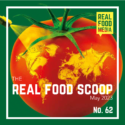by Anna Lappé
You know organic food has gone mainstream when Men’s Health waxes poetic about an organic diet in between shout-outs to a “hot new sex app” and pictures of actress Chelsea Peretti in stilettos. And you know the business of organic is moving out of the margins when CNBC’s ornery “Mad Money” host, Jim Cramer, describes organic as “one of the most lucrative trends of our era.” Sounding more like a permaculture geek than a money manager, Cramer recently said:
Many people will probably tell you that organic food is really just for rich people, that it’s not an economical way to approach agriculture, that it can’t feed the world. Well, guess what? None of that’s true.
For years, the organic food industry boasted that it was experiencing double-digit growth year to year. That’s not so impressive when your products are less than 1 percent of the total market. But that’s all changing.
While chemical agriculture defenders like to say that organic food is still marginal, that’s becoming less and less true. Today organic food sales are 5 percent of the total — but even that figure hides the true heft of the industry. Most of American farmland is dedicated to industrial crops — commodities such as corn and soybeans — that are mainly used in animal feeds, sweeteners or ethanol production rather than eaten by people directly. If you consider the organic percentage of food we eat, the figures grow: 12 percent of fruit and vegetable sales and 7 percent of dairy are organic. For certain crops, the figures jump. “Organic carrots make up 23 percent of the market. Organic kale is 50 percent of the total,” said Laura Batcha, the executive director of the Organic Trade Association.
Choosing organic produce and grains means eschewing foods that were irradiated (treated with radiation, often to slow the sprouting or ripening process or to increase shelf life), made with genetically engineered seeds or fertilized with sewage sludge. Choosing organic-certified meat or poultry means reaching for products raised without artificial growth hormones, antibiotics and a bevy of other drugs, including arsenic-based ones. Those are just a few reasons consumers are choosing organic-certified foods in the marketplace. The benefits of doing so — from personal health to environmental sustainability — are becoming increasingly clear to American consumers.
Companies are catching on. Last month, Chipotle became the first major fast-casual chain to declare it would be breaking up with genetically engineered ingredients, for the most part. (Unless it drops soda and shifts entirely to organic-certified sources for meat and dairy, it is still selling foods that have been made with genetically engineered ingredients.) While a partial shift, this very public move is evidence that companies are feeling the consumer demand for healthier and more ecological food.
From my conversations with consumers across the country, there is a tsunami of demand for these products. National polls reflect the sentiment I’ve been hearing on the ground. In a 2015 survey (PDF) conducted by Wolfe Research, 55 percent of female respondents ranked natural and organic as extremely important or very important in their purchasing decisions, up from 43 percent in 2013.
All of this has companies with big investments in chemical agriculture — from animal pharmaceutical giants (Elanco) to chemical companies (Bayer) and biotech behemoths (Monsanto) — doubling down on their public relations campaigns to tamp down consumer demand for organic.
These companies and their trade groups, such as the Biotechnology Industry Organization and CropLife America (the gussied-up version of the National Association of Chemical Manufacturers), are spending hundreds of millions of dollars every year to combat popular concerns about the chemical cocktails used on farm fields or genetic engineering used on seeds.
They’re also investing in front groups, nonprofit organizations established to be perceived as working in the public interest but effectively PR arms for industry that pour millions into marketing campaigns. Take Elanco, which is a member of the Industry Partner Council of the U.S. Farmers and Ranchers Alliance, whose communications efforts include a campaign countering concerns about antibiotic overuse on factory farms — this despite the well-founded science on dangerous antibiotic-resistant bacteria fostered by just such overuse.
For a forthcoming Friends of the Earth report on the food industry’s corporate spin, I reviewed the expenses of 14 of these nonprofit food industry front groups, seven of which were launched since 2009. Based on filings with the Internal Revenue Service, these groups spent more than $135 million on media campaigns, websites, media representative training and more from 2009 to 2013. That figure doesn’t even include the more than half a billion dollars spent by just three trade associations — the Grocery Manufacturers Association, CropLife America and the Biotechnology Industry Organization (BIO) — in that period. (Note: BIO’s spending includes amounts for agricultural and health care biotechnology.)
All this money is having an effect. The PR firm Ketchum, for example, was employed last year by BIO to develop a campaign to improve public perception of genetically modified organisms, including developing GMOAnswers.com, a website with industry-approved commentary about GMOs. As part of this work, Ketchum seeks out negative biotech-related tweets and points authors toward GMOAnswers.com. Since its launch, said a Ketchum representative in Delta Farm Press, “There’s been about an 80 percent reduction in negative Twitter traffic as it relates to GMOs.”
This infusion of well-funded spin is distorting the conversation about food, health and sustainability. As organic food sales boom, some of the most lucrative companies in the world are threatened. In response, these companies are spending more than ever to shape the conversation about food and sustainability. As they do, it’s all the more essential that the public make informed choices based on science, not spin. Fortunately, despite the millions being spent on it, more people are exposing this spin, and organic continues to go mainstream — whether the chemical and biotech industry likes it or not.
Originally published in Al Jazeera America
Photo by Tim Psych/Flickr




